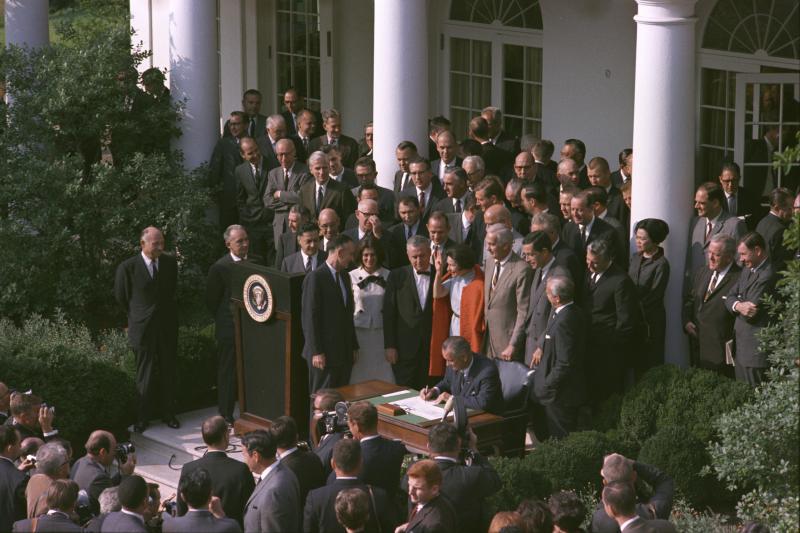1965

President Lyndon B. Johnson signing the Arts and Humanities Act on September 29, 1965. Photo courtesy of the Lyndon Baines Johnson Presidential Library
On September 29, 1965, President Lyndon B. Johnson signed P.L. 89-209, the National Foundation on the Arts and the Humanities Act, in the Rose Garden of the White House. This piece of legislation established the National Endowment on the Arts and the Humanities Foundation as an umbrella for the National Endowment for the Arts (NEA), the National Endowment for the Humanities (NEH), and their respective councils. On this occasion, President Johnson said: "Art is a nation's most precious heritage. For it is in our works of art that we reveal ourselves, and to others, the inner vision which guides us as a nation. And where there is no vision, the people perish."
This new law was the fruit of two presidents, several senators and representatives, and four previous pieces of legislation. Separate bills had been introduced, in previous years, into the House by Representative Frank Thompson (D-NJ), and into the Senate by Senators Hubert Humphrey (D-MN) and Jacob Javits (R-NY). Senator Claiborne Pell (D-RI) had overseen hearings on some of this preliminary legislation, beginning in October 1963, before the death of President John F. Kennedy.
With Roger L. Stevens appointed as its first chairman, the NEA began its first fiscal year with a budget of $2.5 million dollars and fewer than a dozen employees. Six programs were started in that first year: Music, Dance, Literature, Visual Arts, Theater, and Education—while some 22 institutions and 135 individual artists were funded by the agency. Mr. Stevens remarked, "We believe that the time has come for our society to give not merely ceremonial honor to the arts, but genuine attention and substantive support."
In the new agency’s first action, the NEA responded to an emergency grant request for $100,000 from the American Ballet Theatre, which was in critical need of immediate assistance. On December 20, 1965, Vice President Hubert Humphrey presented the first check issued by the federal government in direct support of the arts, assuring the continued operation of one of the country’s best existing full-scale dance companies. The New York Herald Tribune reported: "The Treasury of the United States has saved a national treasure. Not directly, perhaps, but the taxpayers, through the government's recently established National Council on the Arts, saved the American Ballet Theatre from extinction."

